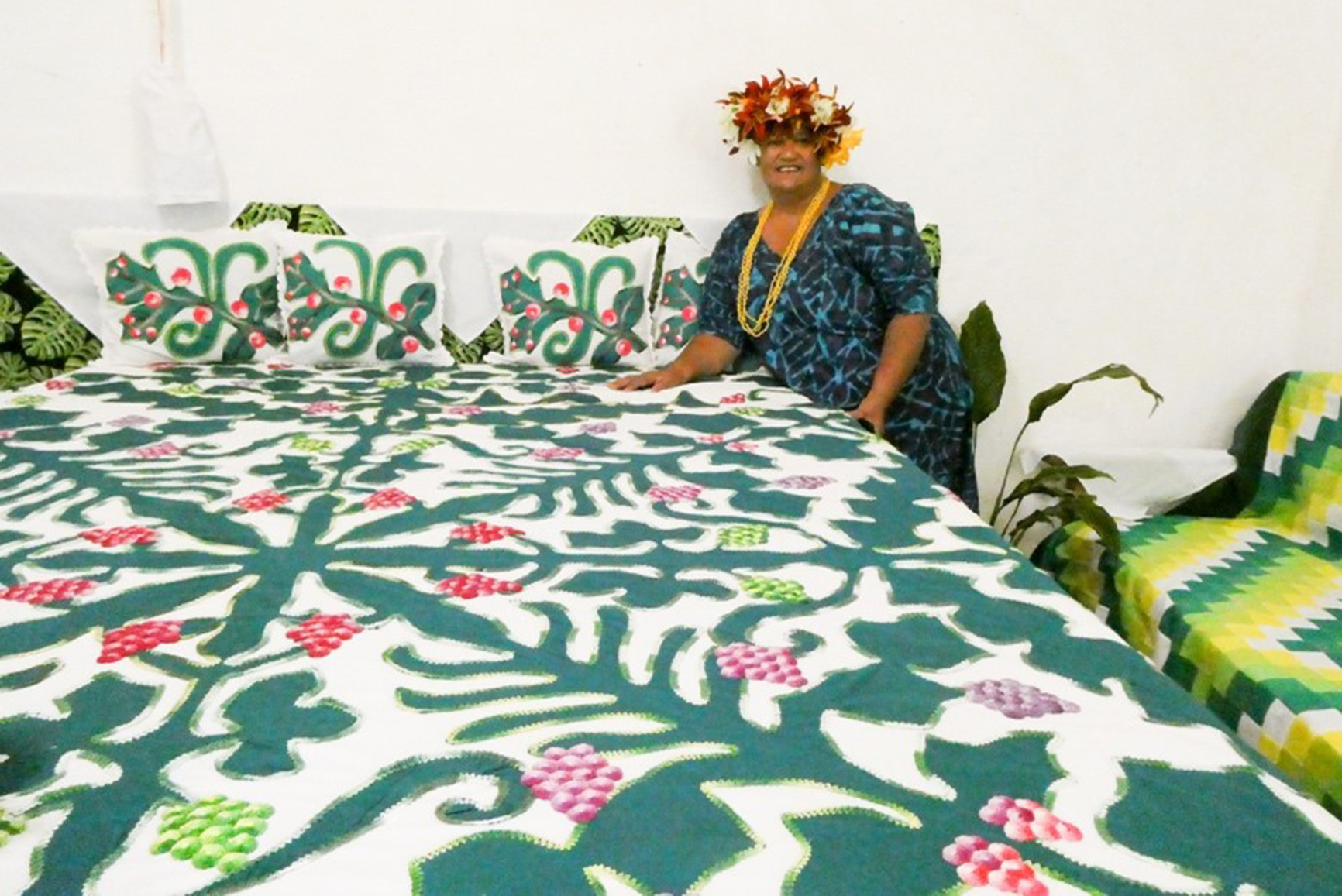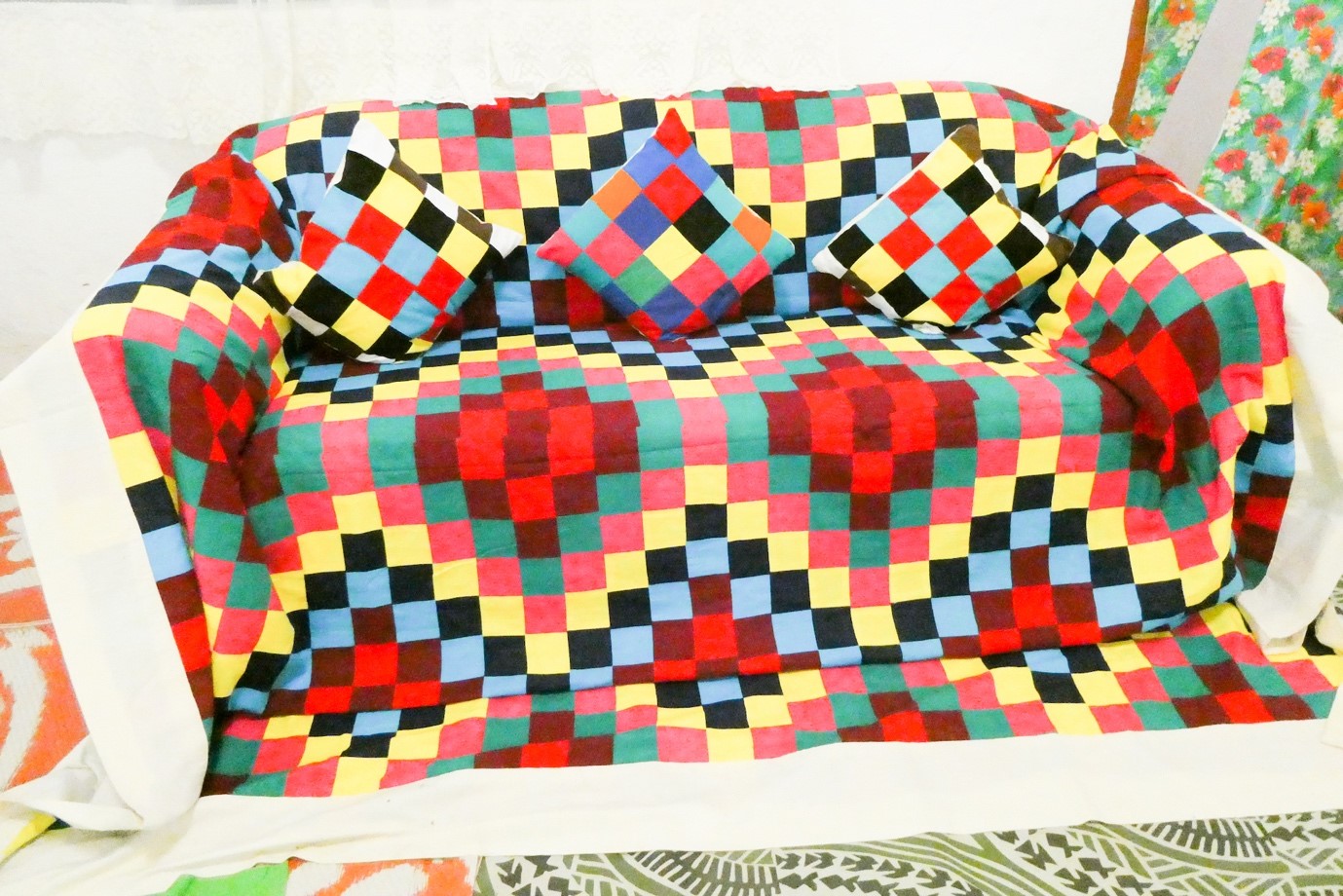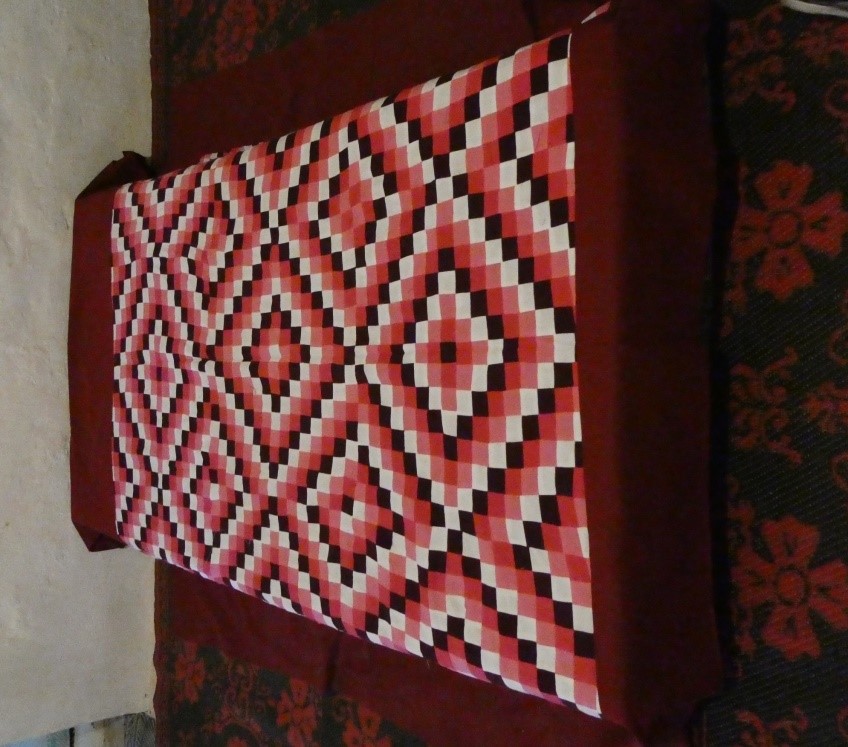Tivaivai treasures on display in Mangaia
Saturday 26 November 2022 | Written by Supplied | Published in Features, Go Local

Tivaivai design by Matapo Koroa (pictured) with crochet grape motifs made by her sister Ngatamaine. PICTURE: Pam Steele 22112519/ 22112520
A magnificent display of newly made tivaivai was held on Mangaia recently, organised by the women’s group (vainetini) from the Cook Islands Christian Church (CICC), Oneroa. By Pamela Steele.
The display was held in the old Mission House with the rooms and verandah completely filled with tivaivai in every style and colour.
The tivaivai exhibition followed a workshop organised by Teku Tereora, wife of the current minister of the Oneroa church.
It featured work that resulted directly from knowledge and skills passed on at that workshop using cloth and sewing machines purchased from a Social Impact Fund grant from the Ministry of Internal Affairs.
The vainetini have established a revolving fund, with materials purchased from the grant being sold to members and the money put back into the fund for future use.

Tivaivai taorei made by Tekura Tereora. PICTURE: Pam Steele/22112518
Three electric sewing machines were also purchased under the grant and placed in a central place in each of the island’s three villages.
There are nine women in the Oneroa CICC vainetini group and the materials and machines were a great help in enabling them to make new tivaivai and put on the exhibition.
Mama Ne Tangimataiti, who had several tivaivai on display, explained what it was like making tivaivai in the days before modern sewing machines.
“A tivaivai taorei was made up of very, very, small patches, the colour sequence was marked on a string, and each mama would take away a string and follow the sequence of colours in sewing together the different coloured patches into bands. Then they would come together in a group and sew them all into one tivaivai. And all this would be accompanied by chatting and gossip and exchange of news,” says Tangimataiti.
“In those days the cotton was easy to rip and the squares on the tivaivai taorei were so much smaller, about a square inch – sometimes as many as 40,000 pieces of cloth to a tivaivai, so it made sense to share the work around a larger group,” Mama Ne recalled.
“These days the synthetic fabrics are harder to tear, the squares are larger and most people prefer to work on their own tivaivai at home but still go to workshops to share their knowledge and experience.”

Tivaivai tataura design. PICTURE: Pam Steele/22112523
Teina Stringer, another member of the Oneroa vainetini, said the tivaivai means a lot to the women and their families both as an art creation by an individual and as an heirloom to pass down through the generations.
“It’s been an old art since missionary times. And the idea is to pass on the knowledge from one generation to another. It’s a living, ongoing thing,” she said.
“We’ve been lucky to have Mama orometua Teku Tereora with us, a tivaivai ta’unga who’s been enhancing our knowledge of design, cutting, and matching colour – sharing her own extensive knowledge.
“If you want a tivaivai for a single, double or queen size bed, she will tell you how much material to get but the colour is always your own choice.”
Stringer said some of the younger generation are learning the knowledge.
“Young girls and boys came to our first workshop, from all three villages on Mangaia and helped with cutting materials. Later they held their own exhibition.”
Stringer is confident that the art will continue into the next generation.
“It’s up to the encouragement of the group and leaders, like Mama orometua, a very talented woman, a ta’unga who is always willing to share her knowledge and skills and encourage the young people”, she said.
Tivaivai are also made and displayed outside the Cook Islands in places such as New Zealand and Australia. One of the tivaivai in the Oneroa exhibition that attracted great attention, was made by Matapo Koroa, and included a series of crocheted grapes made by her sister Ngatamaine who lives in Australia.
The Mangaian mamas at the exhibition also talked about the problems for older women when their eyesight was no longer so good.
“You need good eyesight or good prescription glasses to sew a tivaivai but prescription glasses are hard to get in the outer islands and are very expensive,” said Mama Ne Tangimataiti.
“But in the old days before we had power, and before electric sewing machines, the old people still managed to sew their tivaivai!”
Mama Ne Samuela, also a member of the Oneroa CICC vainetini, said the difficulty in getting good cotton, which could be easily ripped into squares, had changed the style of tivaivai being made these days.
“The synthetic materials are very hard to tear to make the traditional quilts and so many of us now prefer to do embroidery and then join the embroidered pieces to make the tataura design,” she said.
“Then we can sit in our homes or I can sit in my shop and embroider the pieces when I have time and later attach them to the backing to make up a larger tivaivai piece.”
Mama Ne Samuela said she had worked hard to get three new tivaivai ready for the Oneroa exhibition, adding she will try and make 10 more over the next two years for the 2024 bicentennial celebration of the Gospel’s arrival to Mangaia.

Tivaivai taorei design made by Ne Tangitamaiti. PICTURE: Pam Steele/22112524
In earlier times, groups of women in tere parties would visit the outer islands or Rarotonga to share stories and display their tivaivai however these days most displays are held locally with exhibitions also held in the villages of Ivirua and Tamarua on Mangaia each year.
According to Mama Ne Samuela groups from each village meet every now and then to discuss the number of tivaivai to be made for the annual display.
“Ivirua has more people than Oneroa and Tamarua so it will be a big show with Ivirua women making about eight tivaivai each for their show,” she said.
There are four different types of tivaivai design in the Cook Islands: tivaivai manu, tivaivai taorei, tivaivai tataura and tivaivai paka’onu.
Tivaivai manu uses applique and is the simplest of all the styles in which coloured cloth is folded and cut into patterns before being stitched onto a backing cloth in a contrasting colour.
The tivaivai tataura style is the most distinctive Cook Islands’ style which uses embroidery to highlight a pattern, often large groups of floral blossoms and leaves with the embroidery used to reflect shading. This style is popular with the Mangaia women as they can embroider pieces in their own time, and later make up a larger quilt, throw or pillow covers.
The tivaivai taorei is one of the earliest styes introduced to the Cook Islands and involves thousands of small pieces of cloth shaped in diamonds, hexagonals or squares joined together to form a mosaic.
The Oneroa display was a splendid collection of all the different styles of tivaivai and after just one day on display, the treasures were carefully packed away and returned to their storage boxes to be kept for the next special occasion or given away as a gift to family and friends.
The next big target for the Mangaian vainetini is the 2024 bicentennial of the arrival of the Gospel. Ne Tangimataiti said the women have all undertaken to create 10 new tivaivai each for the celebrations – a massive task.














































